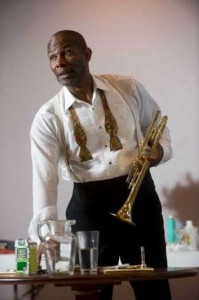Check It Out: Satchmo At The Waldorf
 I saw a terrific new play last night called Satchmo at the Waldorf. The play is by the Wall Street Journal critic Terry Teachout, who has been cited before at Jazz Collector for an article he wrote several years ago called “Can Jazz Be Saved?” This is Teachout’s first play and he’s done a remarkable job of piercing through the public persona of Armstrong and giving us a portrait of the man and musician. Teachout’s writing is aided considerably by the performance of John Douglas Thompson in a dynamic solo effort in which he plays Armstrong as well as his long-time manager Joe Glaser and Miles Davis. The play takes place backstage at the Waldorf Astoria hotel in New York just several months before Armstrong’s death in 1971. I would hope and expect that most of the readers here at Jazz Collector recognize the genius of Armstrong and his seminal contributions to jazz even though we don’t write about him very often. Indeed, he is not part of the “Jazz Collector Era” we talk about and his records are not often among the collectible Blue Notes and Prestiges that make up the bulk of our postings. But none of the music we love and cherish here happens without him coming first, right?
I saw a terrific new play last night called Satchmo at the Waldorf. The play is by the Wall Street Journal critic Terry Teachout, who has been cited before at Jazz Collector for an article he wrote several years ago called “Can Jazz Be Saved?” This is Teachout’s first play and he’s done a remarkable job of piercing through the public persona of Armstrong and giving us a portrait of the man and musician. Teachout’s writing is aided considerably by the performance of John Douglas Thompson in a dynamic solo effort in which he plays Armstrong as well as his long-time manager Joe Glaser and Miles Davis. The play takes place backstage at the Waldorf Astoria hotel in New York just several months before Armstrong’s death in 1971. I would hope and expect that most of the readers here at Jazz Collector recognize the genius of Armstrong and his seminal contributions to jazz even though we don’t write about him very often. Indeed, he is not part of the “Jazz Collector Era” we talk about and his records are not often among the collectible Blue Notes and Prestiges that make up the bulk of our postings. But none of the music we love and cherish here happens without him coming first, right?
In Satchmo at the Waldorf Teachout takes us backstage after a performance. He uses the device of Armstrong dictating his life story into a tape recorder, but Armstrong realizes he is in the more comfortable setting of talking directly to an audience. A lot of the play covers the complex relationship between Armstrong and Glaser, which provides some of the dramatic tension that brings good theater to life. There are more than passing references to Armstrong’s relationship to the boppers, particularly Dizzy Gillespie and Miles Davis, and the deep pain and injustice he felt at being called an Uncle Tom.
